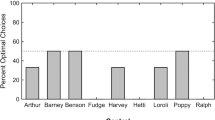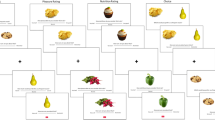Abstract
The less-is-better effect emerges when an option of lesser quantitative value is preferred or overvalued relative to a quantitively greater alternative (e.g., 24-piece dinnerware set > 24-piece dinnerware set with 16 additional broken dishes; Hsee, 1998, Journal of Behavioral Decision Making, 11, 107–121). This decisional bias emerges when the option of lesser quantitative value is perceived as qualitatively better (e.g., smaller set of intact dishes > larger set of partially broken dishes). Interestingly, this effect emerges for adult humans when options are evaluated separately but dissipates when options are considered simultaneously. The less-is-better bias has been attributed to the evaluability hypothesis: individuals judge objects on the basis of easy-to-evaluate attributes when judged in isolation, such as the brokenness of items within a set, yet shift to quantitative information when evaluated jointly, such as the overall number of dishes. This bias emerges for adult humans and chimpanzees in a variety of experimental settings but has not yet been evaluated among children. In the current study, we presented a joint evaluation task (larger yet qualitatively inferior option vs. smaller yet qualitatively superior option) to children aged 3 to 9 years old to better understand the developmental trajectory of the less-is-better effect. Children demonstrated the bias across all choice trials, preferring an objectively smaller set relative to a larger yet qualitatively poorer alternative. These developmental findings suggest that young children rely upon salient features of a set to guide decision-making under joint evaluation versus more objective attributes such as quantity/value.



Similar content being viewed by others
References
Bjorklund, D. F. (2022). Children’s thinking: Cognitive development and individual differences (7th ed.). SAGE Publications.
Brainerd, C. J., Reyna, V. F., & Zember, E. (2011). Theoretical and forensic implications of developmental studies of the DRM illusion. Memory & Cognition, 39, 365–380.
Davidson, D. (1995). The representativeness heuristic and the conjunction fallacy effect in children’s decision making. Merrill-Palmer Quarterly, 41, 328–346.
De Neys, W., & Vanderputte, K. (2011). When less is not always more: Stereotype knowledge and reasoning development. Developmental Psychology, 47, 432–441.
Do, A. M., Rupert, A. V., & Wolford, G. (2008). Evaluations of pleasurable experiences: The peak-end rule. Psychonomic Bulletin & Review, 15, 96–98.
Epstein, S. (1994). Integration of the cognitive and the psychodynamic unconscious. American Psychologist, 49, 709–724.
Evans, J. S. B. (2008). Dual-processing accounts of reasoning, judgment, and social cognition. Annual Review of Psychology, 59, 252–278.
Felmban, W. S., & Klaczynski, P. A. (2019). Adolescents’ base rate judgments, metastrategic understanding, and stereotype endorsement. Journal of Experimental Child Psychology, 178, 60–85.
Finucane, M. L., Alhakami, A., Slovic, P., & Johnson, S. M. (2000). The affect heuristic in judgments of risks and benefits. Journal of Behavioral Decision Making, 13, 1–17.
Haines, B. A., & Moore, C. (2003). Integrating themes from cognitive and social cognitive development into the study of judgment and decision making. In S. L. Schneider & J. Shanteau (Eds.), Emerging perspectives on judgment and decision research (pp. 246–286). Cambridge University Press.
Hsee, C. K. (1996). The evaluability hypothesis: An explanation for preference reversals between joint and separate evaluations of alternatives. Organizational Behavior and Human Decision Processes, 67, 247–257.
Hsee, C. K. (1998). Less is better: When low-value options are valued more highly than high- value options. Journal of Behavioral Decision Making, 11, 107–121.
Hsee, C. (2000). Attribute evaluability: Its implications for joint-separate evaluations and beyond. In D. Kahneman & A. Tversky (Eds.), Choices, values and frames. Cambridge University Press.
Hsee, C. K., Loewenstein, G. F., Blount, S., & Bazerman, M. H. (1999). Preference reversals between joint and separate evaluations of options: A review and theoretical analysis. Psychological Bulletin, 125, 576–590.
Jacobs, J. E., & Potenza, M. (1991). The use of judgement heuristics to make social and object decisions: A developmental perspective. Child Development, 62, 166–178.
Kahneman, D. (2003). A perspective on judgment and choice: Mapping bounded rationality. American Psychologist, 58, 697–720.
Kahneman, D., & Thaler, R. H. (2006). Anomalies: Utility maximization and experienced utility. Journal of Economic Perspectives, 20, 221–234.
Kahneman, D., & Tversky, A. (1979). Prospect theory: An analysis of decision under risk. Econometrica, 47, 263–292.
Klaczynski, P., Daniel, D. B., & Keller, P. S. (2009). Appearance idealization, body esteem, causal attributions, and ethnic variations in the development of obesity stereotypes. Journal of Applied Developmental Psychology, 30, 537–551.
Klaczynski, P. A., Felmban, W. S., & Kole, J. (2020). Gender intensification and gender generalization biases in pre-adolescents, adolescents, and emerging adults. British Journal of Developmental Psychology, 38, 415–433.
List, J. A. (2002). Preference reversals of a different kind: The “more is less” phenomenon. American Economic Review, 92, 1636–1643.
Mah, E. Y., & Bernstein, D. M. (2019). No peak-end rule for simple positive experiences observed in children and adults. Journal of Applied Research in Memory and Cognition, 8, 337–346.
Menzel, E. W., Jr. (1960). Selection of food by size in the chimpanzee, and comparison with human judgments. Science, 131, 1527–1528.
Menzel, E. W., Jr. (1961). Perception of food size in the chimpanzee. Journal of Comparative and Physiological Psychology, 54, 588–591.
Parrish, A. E., & Beran, M. J. (2014). Chimpanzees sometimes see fuller as better: Judgments of food quantities based on container size and fullness. Behavioural Processes, 103, 184–191.
Parrish, A. E., Evans, T. A., & Beran, M. J. (2015). Defining value through quantity and quality—Chimpanzees (pan troglodytes) undervalue food quantities when items are broken. Behavioural Processes, 111, 118–126.
Reyna, V. F., & Brainerd, C. J. (1991). Fuzzy-trace theory and framing effects in choice: Gist extraction, truncation, and conversion. Journal of Behavioral Decision Making, 4, 249–262.
Reyna, V. F., & Brainerd, C. J. (2011). Dual processes in decision making and developmental neuroscience: A fuzzy-trace model. Developmental Review, 31, 180–206.
Reyna, V. F., & Ellis, S. C. (1994). Fuzzy-trace theory and framing effects in children’s risky decision making. Psychological Science, 5, 275–279.
Stanovich, K. E., & West, R. F. (2000). Advancing the rationality debate. Behavioral and Brain Sciences, 23, 701–717.
Strough, J., Karns, T. E., & Schlosnagle, L. (2011). Decision-making heuristics and biases across the life span. Annals of the New York Academy of Sciences, 1235, 57–74.
Toplak, M. E., West, R. F., & Stanovich, K. E. (2013). Assessing the development of rationality. In H. Markovits (Ed.), The developmental psychology of reasoning and decision-making (pp. 7–35). Psychological Press.
Tversky, A., & Kahneman, D. (1974). Judgment under uncertainty: Heuristics and biases. In M. H. Bazerman (Ed.), Negotiation, decision making and conflict management (Vols. 1–3, pp. 251–258). Edward Elgar Publishing.
Tversky, A., & Kahneman, D. (1981). The framing of decisions and the psychology of choice. In D. A. Balota & E. J. Marsh (Eds.), Cognitive psychology: Key readings (pp. 621–630). Psychology Press.
Author note
Research support was sponsored by a research grant via the School of Humanities and Social Science at The Citadel. We have no conflicts of interest to disclose. The authors thank the parents and museum staff for their assistance.
Statement on data sharing
All raw data for choice behavior as a function of trial type are freely available online (https://osf.io/5hpq6/).
Author information
Authors and Affiliations
Corresponding author
Additional information
Publisher’s note
Springer Nature remains neutral with regard to jurisdictional claims in published maps and institutional affiliations.
Rights and permissions
Springer Nature or its licensor (e.g. a society or other partner) holds exclusive rights to this article under a publishing agreement with the author(s) or other rightsholder(s); author self-archiving of the accepted manuscript version of this article is solely governed by the terms of such publishing agreement and applicable law.
About this article
Cite this article
Parrish, A.E., Sandgren, E.E. The less-is-better effect: a developmental perspective. Psychon Bull Rev 30, 2363–2370 (2023). https://doi.org/10.3758/s13423-023-02318-x
Accepted:
Published:
Issue Date:
DOI: https://doi.org/10.3758/s13423-023-02318-x




